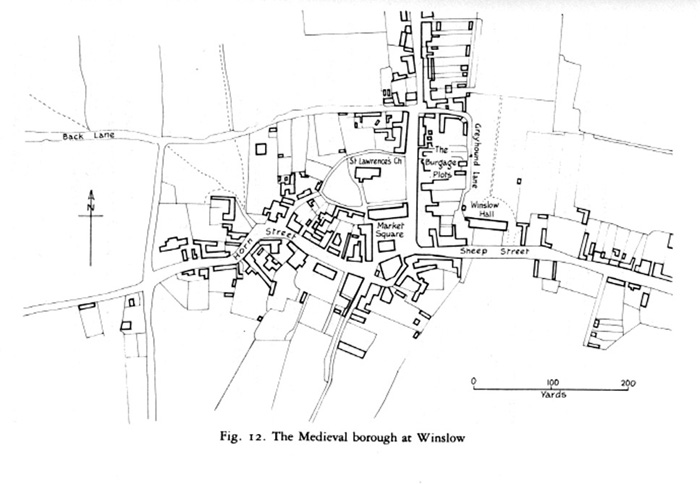
The New Town of Winslow: the burgage plots
The evidence for burgage plots in Winslow comes from the Hundred Rolls (1279):
In burgage, 10 burgesses of the same tenure, of whom each owes 3s a year, and they are these: Nicholas Marescall, Gilbert Smat, William Bendenes, William Bani, John son of Peter, John Bani, Hugh Log’, John Bastard, Adam Luc’, Hugh Bastard.
This is placed confusingly in the entry for Shipton, but must refer to Winslow itself. The successors of these burgesses appear to be the inhabitants of the Nova Villa de Wynselowe which is frequently mentioned in the Court Books from 1350 onwards. It was a distinct administrative unit with its own chief man, Roger atte Welle, and an annual fine of 2s payable to the Abbot separately from Winslow and Shipton. It does not occur in the 15th-century records, and in many places burgage tenure fell into disuse in the 15th century as lords of manors preferred to lease out their estates (Goddard 2011, 29).
The location of the burgage plots seems to be the east side of the High Street, as suggested by Michael Reed, The Buckinghamshire Landscape (1979), fig.12:

Their outline can still be seen on the present-day map, with Greyhound Lane being the rear access lane with which burgage plots were normally equipped. Some of them had been split up by 1342, when entries from the Court Books refer to plots “in length 165 feet and in width 17 feet at one end and 23 feet in the middle and 40 feet at the other end” and “in length 108 feet and in width 18 feet at one end and 17 feet at the other end”. 165 feet (10 perches) corresponds roughly to the length of the modern plots.
It is likely that the plots were laid out at the time of the market charter (1235), at the same time that the market-place was created. There are many similar examples from the Midlands in the 13th century (Goddard 2011, 11). Burgage tenure was originally a form of free tenure which involved a cash rent and no labour services, encouraging free movement and commercial enterprise. Originally the burgesses did not hold land, but the general tendency in predominantly agricultural settlements was for them to acquire land in addition to their burgage plots. Goddard (2011, 30) argues that it is mistaken to see small boroughs as “urban failures”, and that they were really “adaptable economic zones whose commercial features were switched off and on by those with a vested interest in them.” Hence, Winslow’s borough was probably never intended to be a rival to Buckingham and Aylesbury, but was an aspect of developing Winslow as a market centre which served its purpose in the 13th and 14th centuries, and disappeared from the organisation of the manor (although not from its physical layout) when it no longer benefited the Abbot in the 15th century.
See: Richard Goddard, “Small boroughs and the manorial economy: enterprise zones or urban failures?”, Past & Present 210 (2011), 3-31.
